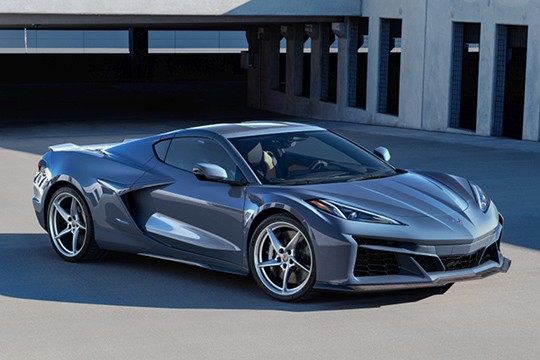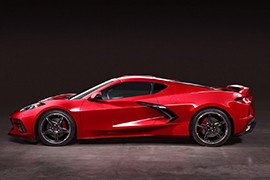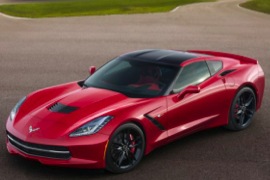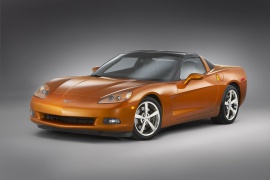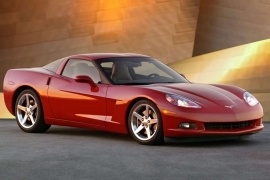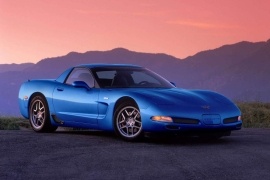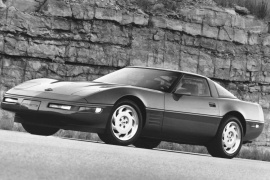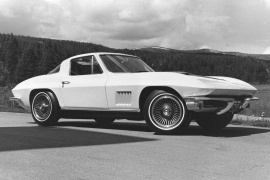CHEVROLET Corvette Coupe Models/Series Timeline, Specifications & Photos
First production year: 1956
Engines: Hybrid gasoline, Gasoline
Body style: Coupé (two-door)
The eighth generation of the Corvette broke covers in 2020, and it was the most significant upgrade in the model’s history since, unlike its predecessors, it didn’t have the engine mounted at the front but behind the cabin. And then, in January 2023, the American automaker shook its customers once more with the introduction of the E-Ray on the market.
In January 2023, seven decades after the launch of the original Corvette at New York’s Motorama in 1953, GM unveiled the most technologically advanced version of this nameplate: the E-Ray. Its name suggested a connection with the Stingray, and unlike the rest of the C8 Corvette range, it was an electrified version. Still, GM didn’t adopt this solution just for environmental concerns but to improve the car’s performance. The increased fuel efficiency compared to its stablemates was just a bonus. In addition, the E-Ray was also the first all-wheel-drive Corvette in the model’s history.
The E-Ray shared its bodywork with the Corvette Z06, meaning that it looked more aggressive than the Stingray. At the front, the lower splitter underneath the bumper featured two wide scoops on the sides that flanked a center grille. The short hood was continued by the raked windshield and the roof. From the sides, the wide air intakes fed the engine placed behind the cabin. Unlike its roadster sibling, the E-Ray coupe featured a sloped-down rear window that extended over the engine. Finally, at the back, the automaker installed a small lip spoiler on the deck. For the rear fascia, Chevrolet placed four rectangular-shaped taillights with red underlines, while below the bumper was a quad-exhaust.
With its modern cockpit made for two, the American supercar created a luxurious and sporty environment for its customers. The two high-bolstered seats were separated by a tall center console, while in front of the driver was a digital instrument cluster. In addition, atop the center stack, GM added a touchscreen for the infotainment system, which the driver could control via a turning knob and a few buttons placed next to the gear selector’s buttons. On the passenger side of the center console, the automaker installed a handle-like bar with buttons for the HAVC system and the controls for the heated seats.
But E-Ray’s most significant upgrade compared to its stablemates was found under its skin. Regardless of whether it was in the coupe or roadster shape, the car featured an electrified drivetrain. GM installed the 6.2-liter LT2 V8 engine that powered the rear wheels via an eight-speed automatic transmission. At the same time, the front wheels were moved by a 160 hp (162 PS) motor. The total output power obtained reached 655 hp (664 PS). But the E-Ray could do something more than just help the car get a 2.5-second 0 to 60 mph (0-97 kph) sprint. It could also cruise in “Stealth Mode” via the electric motor only at speeds of up to 45 mph (72 kph). Still, the battery pack was just 1.9 kWh.
Chevrolet introduced the eighth sequel of the Corvette in 2019, and it was the most revolutionary generation in the model's history since it was the first to have the engine mounted behind the cabin.
When Zora Arkus-Duntov joined GM in 1953, he quickly became one of the most notorious engineers in the automaker's department. He liked the Corvette but had many ideas to improve it. One of them was to put the engine behind the cabin. Harley Earl and GM's top management disagreed with it due to high production costs. In 1964, Duntove made the CERV II (Chevrolet Engineering Research Vehicle), a concept car that carried over some elements from the Corvette but had a mid-mounted engine. Unfortunately, the brilliant engineer couldn't convince GM's management that his solution was worth it. Two years later, Lamborghini introduced the mid-engined Miura, which became the first proper supercar in history. Chevrolet continued to create generations after generations of the Corvette, but all followed the front-mounted engine solution. Unfortunately, Mr. Arkus-Duntov passed away in 1996 without seeing that Chevrolet finally applied his solution in 2019, when it launched the eighth generation of the Corvette.
At the front, the C8 Stingray had a short nose and angular-shaped headlights. Its daytime running lights were integrated into the headlamps and followed a V-shape pattern. The deeply sculptured hood channeled airflow to the sides and created downforce as well. The automaker made a fat bumper that sported a broad center grille flanked by a pair of side scoops to complete the car's aggressive stance.
From its profile, the supercar stance of the C8 was continued by the raked and wide windshield and the ascending waistline of the car. A set of massive air intakes grabbed air from the sides and channeled it to the engine area behind the cabin. GM's design team cleverly concealed the door handles in the upper area of these air intakes. It also shaped the rear quarter panels to resemble the coke-bottle styling present on the Corvette ever since the car's third generation. Finally, at the back, the C8 Stingray sported a wing on the rear panel and a set of slim LED taillights. Four rectangular exhausts peaked underneath the rear bumper, flanking a functional diffuser.
By placing the engine behind the cockpit, the automaker could create a better cabin for the two occupants inside. The high-bolstered sports seats were separated by the tall center console that featured a separating panel between occupants, which sported a set of buttons for the transmission and other amenities of the vehicle. In front of the driver, Chevrolet installed a completely digital instrument panel fitted with a 12-inch configurable LCD. Next to it, above the center stack, the automaker added a second touchscreen for the infotainment system.
But the most important part of the C8 Stingray was, obviously, the powertrain. Like most of its predecessors, the C8 was powered by a V8 engine, and it was an upgraded version of the LT1 powerplant installed in the previous Corvette generation. The 6.2-liter naturally-aspirated unit provided up to 490 hp (497 PS). It was paired with an eight-speed automatic (dual-clutch) transmission that sent all the oomph to the rear wheels. As an option, customers could get a titanium exhaust that raised the power by five ponies.
No doubt about it: the C7 Corvette Stingray was the best “old school” Corvette ever. It was the last with front engine and, also, it was the first with a really nice interior.
Its silhouette was easy to recognize. It had the same sharp nose, a long hood, and an aerodynamic greenhouse. In the rear, the short overhang amplified the sport look. On top of that, the roof featured a carbon-fiber removable part that transformed the car from a coupe to a targa bodywork. Also, the hood was carbon-fiber too, to enhance the weight distribution.
Inside, there was a big improvement over the C6, which wasn't that good on materials quality. The dashboard features a mix instrument cluster, with analog dials and a TFT display which could be customized to show the information needed by the driver. On the central console, there was the rotary knob for drive-mode selector with a big, round “ESP-off” button in the middle. Another important improvement was the infotainment system that featured an 8” touch-screen display. The head-up display was kept, but with better functions.
Under the hood, the C7 featured a new, 6.2-liter engine that offered 455 hp and 610 Nm (450 lb-ft) of torque. It could be mated either with a six-speed automatic transmission or a 7-speed manual. The adaptive dampers with Magnetic ride control were upgraded and, on the C7, offered more settings than on the C6. It was the last front-engine, rear-wheel drive Corvette.
Even after five decades since the model introduction in Chevrolet's lineup, the Corvette was still one of the best-known American sports cars, if not the most famous one.
In 2004 the bow-tie brand introduced the Corvette C6 Coupe and, just four years later, it came with an updated package. The long and slim silhouette of the Corvette was always fascinating for car enthusiasts all over the world. It also was one of the quickest and fastest cars for the buck spent. Its lines and the exposed headlights were a big step forward for its design. At a glance, it didn't look so much different than the C2 Vette (apart from the pop-up headlights). The slim vents behind the front wheels and the four exhausts completed the car's sporty image. Its long, sloped and curved rear window was also unique on the market.
The interior was fit for two passengers, with enough legroom and a low seating position. A new, three-spoke steering wheel with buttons on the right one enhanced the driver's experience. On the center stack, Chevrolet offered a 6.5" touch-screen display for the infotainment unit. As an option, the carmaker offered a Bose sound system.
A significant upgrade was under the hood, where the carmaker introduced its new LS3 V-8 engine, with a larger displacement than the LS2, which it replaced. The 6.2-liter powerplant provided 430 hp instead of 405 hp available on the 2004 model. It sent the power to the rear wheels via a six-speed manual transmission, while a 6-speed automatic was on the options list.
The Corvette was the best-known American sports car, and the 2004 model came on the market to confirm that Chevrolet did an excellent job again.
Introduced in the fall of 2004, the C6 Corvette was well received by its fans. It featured new technologies and upgraded systems that made the car a tougher competitor for the best European sports cars.
Even if the C6 was not 100% new, a significant difference was on the headlights. The front headlights deleted the traditional "pop-up" headlights, for the first time since 1963, since the second generation was launched. Like its predecessors, it featured fiberglass bodywork. The raked windshield and short roof formed a low-profile greenhouse, while in the back, a vast curved windscreen resembled the shape of the Corvette "split-window." From its sides, the gaps behind the doors served as door handles. Viewed from behind a four-exhaust system grouped toward the car's center and the four round taillights completed the car's sporty image.
The interior was covered in plastic and leather of higher quality compared to the previous C5 Corvette. An infotainment system with a 6.5" touchscreen was placed on the center console, tilted toward the driver. A head-up display showed the driver information about speed, revs, and lateral acceleration.
Under the hood, there was a new LS2 engine that featured a 6.0-liter displacement and offered 400 hp. It was mated either with a 6-speed manual or a 4-speed automatic. In 2008, Chevrolet added the Z06 engine option with a 7.0-liter V-8 engine (LS7). The suspension still had leaf springs but featured magneto-rheological dampers able to detect road surfaces and adjust the damping rates to those surfaces for better ride control.
Offered exclusively as a fixed-roof coupe affair, the Z06 version of the Corvette's fifth generation came on the market in 2001, and the automaker quickly enhanced it for the 2002 model-year.
Ever since the first generation of this nameplate, the Corvette became an iconic model for the American automaker. Moreover, thanks to its features, it was ahead of its competitors and proved to be a smart buy for those looking for a sports car that could outpace a Porsche 911 at a fraction of that German contender's price. And that was true not only for the 2001 model year, which provided 385 hp (390 PS), but also for the 2002 model year, which came with 20 ponies more.
GM made the Z06 with only one body shape: the coupe. The fastback-coupe or the convertible variations were out of the question for the automaker who intended to provide its flagship sportscar model with the stiffest bodywork they had in the C5's lineup. That was the FRC (Fixed Roof Coupe) variation. Still, the car sported the same front fascia as the rest of its stablemates but with badges on the front fenders that said "Z06 405 HP." In addition, in front of the rear wheels, the automaker installed air intakes that cooled the rotors from that axle.
One of the car's main downsides was the interior, where the automaker put cheap materials, and the fit and finish were below the industry's standards. Still, the high-bolstered bucket seats were a well-deserved addition. Another interesting feature of the car was the Head-Up Display, which was an unusual piece of equipment for a 2001/2002 vehicle.
Certainly, the most significant upgrade made to the car was the tweaked LS6 engine made to produce 405 hp (411 PS), which was also gifted with a titanium exhaust.
It was the last Corvette with pop-up headlights and it brought the 50-50 weight distribution to the range. The C5 generation was a big improvement for the well-known American sports-car.
The Corvette, along with the Mustang, was the only American sports-car continuously produced since its first generation, but it appeared a decade before the “Stang” showed to the party. It was constantly improved and survived all the oil crises of the XX-th century.
Sleek, low, and with a stance that couldn't be mistaken with any other sports-car on the market, the Corvette kept its promise to offer exhilarating performance at a bargain price. There was no other car on the market to sprint as fast as it, and have the same price. The long hood featured two wide bulges on it to evoke the V8 under the hood. The fastback look with a long rear windscreen and the short trunk were some of its characteristics.
Inside, the Corvette didn't offer the same high-quality materials or fittings. But the low seating position and the high center console were typical for a sports-car.
The drivetrain was transaxle with the engine in the front and the gearbox in the back. Unlike its predecessors, the differential was integrated into the gearbox instead and not as a separate unit as before. The LS1, small-block 5.7-liter V8 was upgraded, but it still featured a push-rod configuration, which was considered outdated for most of the European cars. It offered only 345 hp, but due to its high torque at low revs and the light, plastic, bodywork, it could outrun most of the cars on the market. It was offered with either a 6-speed manual or a 4-speed automatic.
After 15 years, the Corvette C3 deserved an honorable retirement and was replaced by the fourth generation of this nameplate, a car that rocked the sports car world.
The C4’s styling and engineering started from a blank sheet of paper. It was designed by a team led by Dave McLellan, who took over the Corvette department from Zora Arkus-Duntov in 1975. With the Malaise Era gone and the horsepower race on, the American sports car had to prove its worthiness and slam the door on European manufacturers such as Ferrari and Porsche. It was a challenging task, but the team mastered it. Furthermore, it was the beginning of the ‘80s, and many outdated rules were already gone, such as the one stating that the headlamps had to be round. Still, a few ideas were carried over on the C4 Corvette, such as the pop-up headlights, the fiberglass bodywork, and the front-engine RWD construction.
McLellan penned the car with a narrow front end where the bumper sported the turn signals and the parking lights flanking the license plate holder. To comply with newer safety regulations, the C4 also featured an additional set of blinkers on the bumper’s sides. Above it, Chevrolet placed the retractable headlights, which, unlike on the C3, featured a single headlamp, not twin-round ones. On the hood, the automaker installed the famous Corvette unique badge with two flags.
From its profile, the low nose and the long hood followed the general idea of a classic sports car. Its panoramic windshield was raked even more than on the C3, but it was slightly taller, providing better headroom. On the front fenders, the C4 sported twin louvers, a design element inspired by the short-lived C2. To comply with U.S. regulations, Chevrolet installed flush door handles on the sides instead of on the upper edge of the doors. The car’s cabin featured a vertical B-pillar, while behind it was a panoramic rear window. This element continued the styling line of the Corvette C2 and the latest versions of the C3. Finally, at the back, on the rear fascia, the automaker installed two round taillights on each side. Like on the C3, the rear window didn’t open.
Inside, Chevrolet installed high-bolstered sports seats that could keep their occupants in place during high-speed cornering maneuvers. The automaker installed a tall center console that sported the buttons for the power windows, the gear stick, and an ashtray. On the center stack, the automaker placed the HVAC control panel and the stereo. Fronting the driver was a rectangular-looking instrument cluster and a two-spoke steering wheel.
Under its skin, the C4 featured a completely new platform developed especially for the Corvette, which featured independent suspension in all corners. Surprisingly, since the engineering team considered the transverse leaf springs a suitable solution, it kept it. Under the hood, GM installed a range of V8 engines paired with either a four-speed manual or a four- and six-speed automatic.
When GM introduced the third generation of the Corvette, it was made in coupe and convertible shape, while a third version, the T-Top, followed for the 1969 model year.
While a coupe was usually lighter than a convertible, thanks to its unibody construction instead of the body-on-frame one, the T-Top was the solution that provided the best of both worlds. Customers could enjoy open-top driving without adding weight or losing the car’s stiffness. The C3 T-Top, or targa-top, was the first in the Chevrolet’s lineup to offer such construction. It wasn’t a body-on-frame, but it still provided the fun of driving under the clear sky.
When Larry Shinoda penned the third generation of the Corvette, he made the vehicle based on the Mako Shark II concept, so the C3’s front fascia featured pop-up headlights with twin lamps on each side. In addition, the V-shaped front area was slightly protected by a chromed stripe from side to side. Lower, in the apron, the automaker added a grille that helped to cool the engine, and underneath it was a slim lip spoiler.
From its side, the Corvette T-Top boasted a set of functional four louvers on the front fenders that helped release the air trapped in the wheel well. Up to the A-pillars, the Corvette C3 Coupe and the C3 T-Top looked the same. The difference was on the cabin, or more specifically on the car’s roof. Unlike its coupe sibling, the T-Top featured two removable panels, one above each occupant, which customers could store in specially designated bags. To place or remove them, one person was enough. These panels were provided in body color or as transparent pieces of glass. Unlike the C2, the C3 had sloped shoulder lines behind the cabin, but the rear window was vertical, right behind the seats. Finally, at the back, the 1968 Corvette had the same twin taillights design.
Inside, Chevrolet installed a new dashboard compared with the twin-cowl one used on the C2. Fronting the driver was an instrument panel with two large dials for the speedometer and tachometer. On the center stack, GM installed four gauges for other relevant information and a clock. Between the bucket seats, the car featured a center console that housed the gear selector, the controls for the HVAC, and an ashtray. With the top panels removed and the rear window rolled down, the car offered almost the same pleasant sensations as a convertible. Still, the longitudinal bar above occupants’ heads and the safety arch behind the seats remained.
Under the hood, Chevrolet installed a wide range of V8 engines paired with a three- or four-speed manual and the newly developed Turbo Hydramatic three-speed automatic. The Positronic limited-slip differential was the same as the one used on the Camaro’s second generation.
Chevrolet kept the second generation of the Corvette for just five years before replacing it with the third generation, which lasted until 1982, surviving the entire Malaise Era.
The muscle car era was at its peak when the automaker introduced the third generation of the Corvette. But while those coupes focused mainly on straight-line acceleration performance, the C3 was a lightweight sports car that could handle better thanks to its independent suspension in all corners, low center of gravity, and better weight distribution. In addition, the C3 was already seen as an American alternative to European sports cars thanks to its high performance per buck value. The design was carried over from the Mako Shark II concept penned by Larry Shinoda under Bill Mitchel’s direction, but the chassis was inherited from the Corvette C2. But there was nothing wrong with that since Zora Arkus-Duntov developed it with racing in mind and with clever solutions such as the transaxle system and independent suspension in all corners.
Chevrolet liked the idea of the pop-up headlights and used the same system on the C3, albeit with a hydraulic system instead of the electrical one used on the C2. A chromed metallic bumper adorned the front fascia, and a broad grille underneath it ensured the engine’s cooling. Lower, below the apron, the automaker added a slim lip spoiler.
From its profile, the front fenders sported functional exhaust vents on the sides, and their upper sections formed an arched line above the wheels. The door panels looked like they had no door handles since these were concealed on their upper side, next to the window, and could be activated by pushing them down. It was a clever idea. Like many other cars from that era, the C3 sported coke-bottle-styled rear quarter panels. Unlike the C2, the C3 had sloped shoulder lines behind the cabin, but the rear window was vertical, right behind the seats. Finally, at the back, the 1968 Corvette had the same twin taillights design.
Inside, the automaker installed a dashboard that lost the twin-cowl design concept from its predecessor and featured a tall panel with a sloped front face. Fronting the driver were two large dials for the speedometer and tachometer, while on the center stack, Chevrolet placed four additional gauges and a clock. Lower, the automaker installed the radio. In front of the side passenger was a storage area with pockets. Between the bucket seats, the Corvette featured a center console that housed the controls for the heater, the gear stick, and the handbrake. As an option, the C3 was also available with air conditioning.
Under the hood, the Corvette Stingray (this time one word) was available with a choice of V8 engines ranging from 300 hp (304 PS) to the 390 hp (395 PS) offered by the LS5 454 powerplant. Later, due to changes in power ratings and increased emission restrictions, the advertised power dropped significantly below 200 hp (203 PS). Unlike the C2, the C3 was available with three- or four-speed manuals and three-speed automatic gearboxes. To stop the sports car, GM installed disc brakes in all corners.
In 1962, Chevrolet started production for the 1963 model year Corvette, and the car was a huge leap above its predecessors thanks to clever engineering and improved car design methods.
While the C1 Corvette was phasing out, Zora Arkus-Duntov and the design team started to work on the C2 in 1960. Unlike the first generation, which was mostly a concept car that evolved into a production model but was not thoroughly developed, the C2 was a different story. Duntov was focused on the car’s balance and suspension, while the main designer, Larry Shinoda, used the wind tunnel to shape the bodywork. Moreover, the car was available as a coupe, unlike the C1, which was offered only as a roadster, with a split window in the back and a nameplate that would live decades to come: the Sting Ray. Yes, it was with two words for the C2.
It was a revolutionary design concept, and that could be seen at the front where Larry Shinoda installed pop-up headlights. This styling idea lived on the Corvette until the 2005 C6. Still, the car retained the twin round headlamps inherited from the 1968 ‘Vette. A slim and broad grille was placed lower, behind the chromed bumpers that resembled those installed on the ’68 Corvette. Another impressive styling element for those times was the taller front fenders.
From its profile, the Corvette Sting Ray showed a raked windshield followed by a short roof and a sloped, boat-tail-like rear end. Duntov didn’t like the split window idea since the vertical slat obstructed the rearview, but Harley Earl and the rest of the team loved it. On the front fenders, the C2 featured exhaust vents, while the rear quarter sported eyebrow-like bulges above the wheel wells. Finally, at the back, below the glass area, Chevrolet installed the fuel-filler cap adorned by a chromed Corvette-specific badge with two flags. The C2 continued the twin-round taillights that were introduced on the 1961 Corvette.
Thanks to the transaxle system adopted by the Corvette, the cabin was roomier than on its predecessor, while the twin-cowl design dashboard featured a more generous glove box in front of the side passenger. Chevrolet installed a new instrument cluster in front of the driver, featuring large dials for the tachometer and speedometer and four additional gauges that flanked them. The center stack housed the radio, the heather’s controls, and a clock, while a narrow console for the transmission tunnel was between the seats. In the back, Chevrolet installed a small shelf since there was no external trunk.
But the most significant upgrades happened under the car’s skin. During 1953 and 1960, the fiberglass technology evolved, and GM could create thinner body panels than on the original Corvette. In addition, since the Sting Ray was a coupe, it was lighter than the open-top C1. Duntov, obsessed with weight distribution, created a transaxle system, which sent the gearbox in the back. He also created an independent rear suspension. Under the hood, the C2 was available exclusively with V8 engines fed either by Rochester fuel injection systems or by four-barrel carburetors. GM offered the Sting Ray a standard four-speed manual with an option for a two-speed automatic.
While the sales of the Corvette picked up after the 1955 refresh when the car got a well-deserved V8 under the hood, Duntov continued to improve the C1 for the 1956 model year.
When Harley Earl penned the Corvette for the 1953 Motorama event, he didn’t realize how successful the little white roadster would be. He also designed it with fin tails and a touch of luxury-oriented details, which wasn’t unusual for a prototype. However, there were a few details that sports car customers didn’t find attractive to such a vehicle, and Duntov spotted them and fixed what had to be fixed. As a result, the Corvette got a second facelift just three years after the model’s introduction, and the results were much appreciated by automotive enthusiasts. In addition, since Ford introduced the Thunderbird as a personal luxury coupe that couldn’t compete in terms of performance with the nimble, lightweight Corvette, GM’s position in the sports car segment was rock solid.
At the front, the C1 had a modified fascia that featured round headlights surrounded by chromed trims. Starting with the 1956 model year, these were no longer in a recessed position as the previous versions. In addition, the turn signals migrated under the headlamps from the lower area of the front fascia where they were for the 1955 model year, and chromed metallic trims underlined them.
While for the 1955 model year changes were very subtle, for the 1956 model, they were much more significant. Besides the reshaped front fenders, the automaker installed new door panels with sculptured areas. To emphasize this change, it even offered the Corvette with two-tone paint. Chevrolet also installed new rear quarter panels, which kept their clean Coke bottle lines uncluttered by the tail fins above the fenders. Finally, at the back, the 1956 Corvette got its taillights mounted above the fenders in narrow clusters. The car also got a new place for the license plate, which was now lower, flanked by bumper elements, not integrated into the trunk’s lid behind a clear plastic as on the previous models.
Inside, the combination of bucket seats wrapped in red leather and the white center section of the dashboard was appreciated by customers. Another important step was the introduction of a center console that housed the gear stick and an ashtray. On the dash panel, the Corvette still featured the same center-located dials and gauges, while the speedometer was right in front of the driver. Behind the cabin, the automaker left a place for the retractable canvas roof. The roll-down windows and the fiberglass removable top were kept and improved.
While the 1955 model year was still available with the Blue Flame inline-six engine, the 1956 version came exclusively with a V8 under the hood. Chevrolet paired it with either a three-speed manual or the Powerglide two-speed automatic. Due to cost reasons, the rear suspension still relied on a rigid axle.
